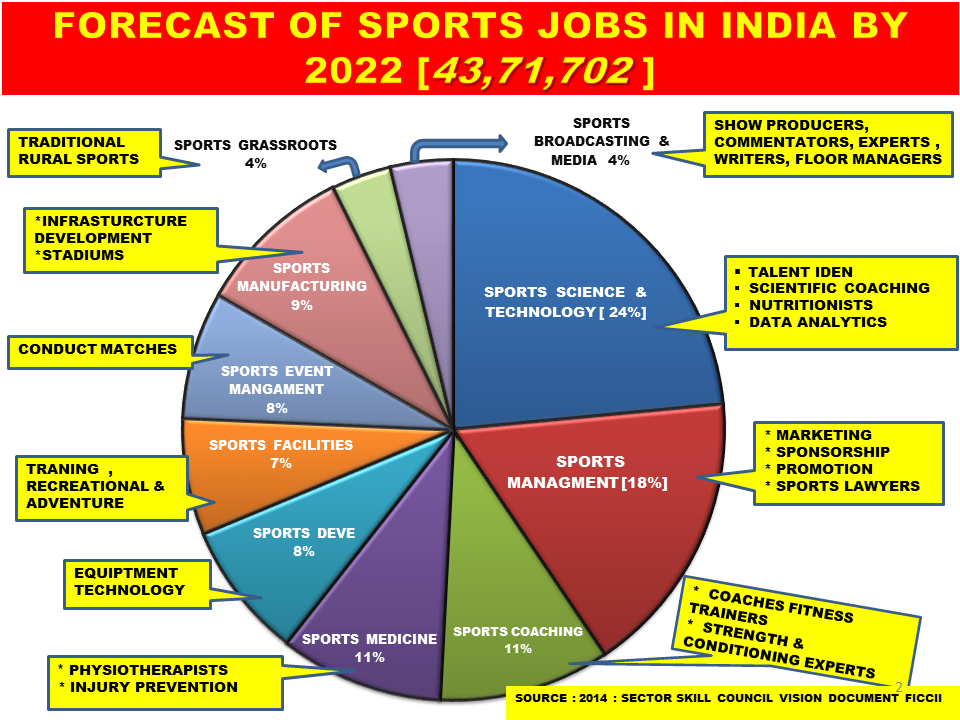The Sports Industry in India has been growing exponentially for the last few years, with significant change ushered in with the emergence of the Indian Premier League (IPL) for the most popular game cricket. The IPL has innovatively and very successfully amalgamated cricket, entertainment, and business. This rare combination has made it an international brand worth $ 4.13 billion value. The stupendous success of the IPL has led to the growth of similar other sporting leagues in India, like the Hockey, Kabaddi, Badminton, Soccer, and various other Leagues. The Leagues have opened up numerous and diverse employment opportunities for the youth. India’s youthful age profile with 63 % of the population between 15 and 64 years of age and 27 % of them in the age bracket of 15 to 29 years is extremely health conscious. Following the age-old dictum ‘Prevention is better than Cure’ and reinforced by the on-going Covid-19 Pandemic, the young and the old are increasingly getting engaged in some form of health fitness and wellness activity to maintain a mentally and physically healthy life. While the World Health Organization made ‘Physical Activity’ the theme for World Health Day on 6 April in 2002, India convinced the U.N. to observe 21 June as Yoga Day. Concomitantly, the construction and refurbishment of Sports Infrastructure with an infusion of state-of-the-art technology have stimulated economic growth and promotion of the Sports Industry. The need for scientific coaching with an emphasis on qualitative instead of quantitative training is imperative to make a mark at the international level. Sports Science has accordingly become an important and inalienable part of the curriculum in renowned global sports universities as well as in India. India’s Khelo India Initiative has provided a tremendous impetus for promoting sports in India and enhancing performance internationally. The Maharaja Bhupinder Singh Punjab Sports University at Patiala has factored these inputs of the emerging sports industry in India to design its courses. The Sector Skill Council of Federation of Indian Chambers of Commerce and Industry(FICCI) has forecasted in 2014 more than 43 Lakh employment opportunities in the Sports Industry for next ten years there are enumerated on the table and chart:-
PROJECTED EMPLOYMENT OPPORTUNITIES BY FICCI FOR 10 YEARS TILL 2025 | |||
SR.NO. | SUB-SECTORS | TOTAL DEMAND BY 2022 | % OF TOTAL |
1. | SPORTS SCIENCES AND TECHNOLOGY | 10,27,681 | 24% |
2. | SPORTS MANAGEMENT | 7,45,984 | 18% |
3. | SPORTS COACHING | 4,47,396 | 11% |
4. | SPORTS MEDICINE | 4,25,839 | 11% |
5. | SPORTS DEVELOPMENT | 3,56,769 | 8% |
6. | SPORTS FACILITIES | 3,04,841 | 7% |
7. | SPORTS EVENT MANAGEMENT | 3,32,667 | 8% |
8. | SPORTS BROADCASTING | 1,62,578 | 2% |
9. | SPORTS GRASSROOTS | 1,57,880 | 2% |
10. | SPORTS MANUFACTURING | 4,10,040 | 9% |
TOTAL | 43,1,675 | 100% | |
Sr.No. | Designation/Post and Pay Scale | Total Vacancy | Qualification Required |
1. | Anthropometrist (Grade II & I) Pay Scale : (Grade II)- 60,000/- to 80,000/- (Grade I)- 40,000/- to 60,000/- | 23 | Master's Degree in Physical Anthropology or Human Biology |
2. | Exercise Physiologist | 34. | Ph.D./Master's Degree in Physiology or Master's Degree in Physiology |
3. | Strength and Conditioning Expert | 62 | Master's Degree in Strength & Conditioning/Sports Science/Sports Coaching/MPED |
4. | Bio mechanist | 5 | Ph.D. Degree in Biomechanics/Sports Science/Bio-Physics |
5. | Psychologist | 4 | Master's Degree in Clinical/Applied Psychology |
6. | Sports Medicine Doctor | 11 | Master's Degree or Post Graduate Diploma in Sports Medicine. |
7. | Physiotherapist | 47 | Master’s Degree in Physiotherapy |
2. The Sports Authority of India (SAI) advertised for the various government posts in SAICentres across Indiaon 31 January 2020. The summary of these posts with brief eligibility criteria is given in the table below for information:-

Another advertisement by the Wrestling Federation is as under
Several other employment opportunities are offered from time to time for Professors in Colleges and Universities; Government Jobs as Directors/ Deputy Directors, Sports Officers at various levels; Coaches at educational institutions like NIS, NSU, LNIPE, National Teams and Associations / Federations and many jobs in the private sector.

